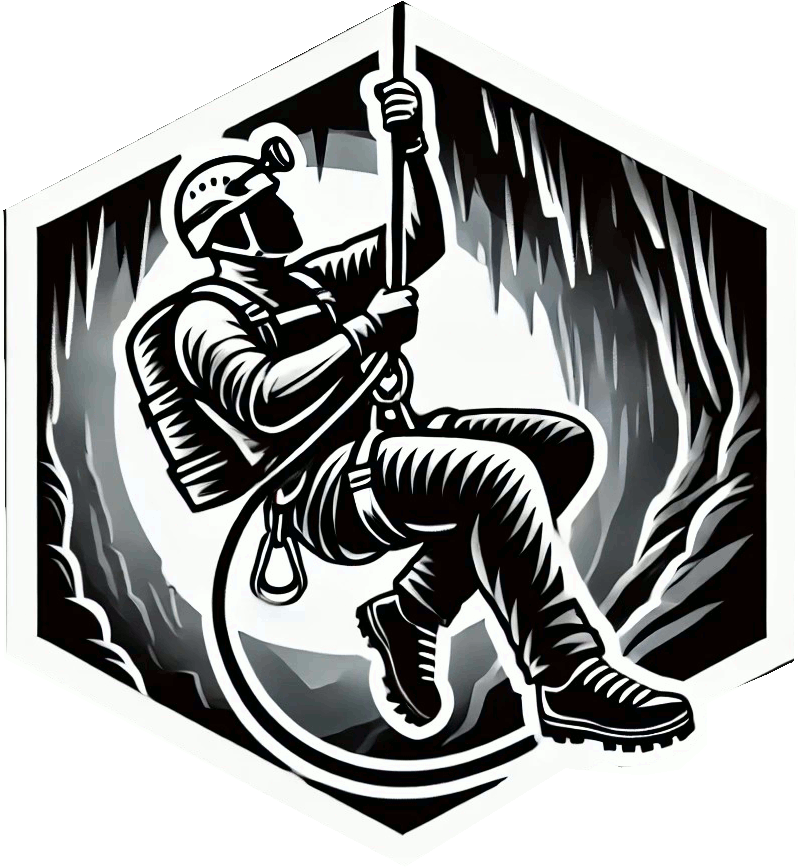Disclaimer: This information is intended as an additional resource for learning about SRT, it is not intended to be used as a replacement to instruction from a qualified professional.
The Kit

The Sit Harness is the harness of choice for the caver. Don’t be tempted to use a climbing harness, the reasons the sit harness is superior for caving are:
- Lower attachment point, meaning far more efficiency as the climber is closer to the rope
- Minimal/small gear loops, meaning less to get snagged in the cave environment.
- Built with more durability and protection from the cave environment.


The attachment point at the front of the sit harness takes a semi circular Carabiner or Mallion . This Mallion or Carabiner acts as the point where gear is attached to the harness.
A useful thing to remember is A B C – which stands for Ascender, Break, Cows Tails. This is the order to load your Carabiner or Mallion ( from right to left ). This is the most convenient SRT setup.
It is good practice to have a detachable foot loop, which can be added to the harness as required.

The chest ascender device, this device is used for climbing rope. The image on the left is a Petzl Croll, a solid and renown choice of chest ascender. This device clips to the users harness and is fixed onto a rope, securing the user to it. When the user moves up the rope, teeth from the ascender are able to also move up, but as they are angled downwards the user cannot then go back down. This allows elevation to be gained and maintained with each push upward. This device is used in European SRT, but not used in the American Ropewalking technique.

The Hand Jammer device is used in a similar way to the chest ascender. The main difference is that the device isn’t directly attached to the users harness. Instead, it is secured via a rope. Then a foot loop is attached to the bottom hole of the hand jammer. The hand jammer is moved up the rope the user then stands in the attached foot loop and pushes down. This moves their body upwards, sliding the chest ascender up the rope. Rinse and repeat until at the top of the rope.
The image to the left here is an example of a simple jammer, some have a full loop for holding. The simple designs are generally preferred by cavers, this is due to larger devices changing body position, which users find disadvantageous.

The foot loop is used to gain elevation on the rope. As previously mentioned, it attaches to the hand jammer. The user puts their foot into the loop and pushes downwards and backward to gain elevation on their chest ascender. Foot loops can be custom made devices like the image on the left, but it is common for cavers just to use an adapted length of rope with knots ties to make attachment points and a loop for a foot.

Cowstails are a key piece of SRT kit, they are used to secure a user to prevent falls when making changes between equipment or navigating difficult sections of cave. They are made up of one section of rope, with two carabiners, usually a figure of eight or overhand knot us used to attach the cows tails to a harness. Barrel knots are used to secure the carabiners in place, keeping them firm and upright, even when just holding the rope below them.
The two tails should be different in length, with one being shorter and the other being longer. The shortest being the safest one to use on the basis that any fall taken on this will gather less momentum. Cows tails should always be dynamic rope, this is the only part of SRT kit that is designed to take a fall.

The Descender, the most fun part of the SRT kit, which of course has to be left until last. This device is what cavers use to descend a rope. Many different kinds of descender exist, each with its own pros and cons. The Petzl Stop (pictured) is a safe bet for a new caver, it contains a breaking system that could prevent an injury in the unexperienced, but its important to understand that this is not a hands free device and loops must be used over the device before taking two hands off. If a hands free device is required look for an alternative like the Petzl Rig/ID.
The most important aspect of using a descender is threading it correctly and testing it on each descent, using the cows tail as a backup until the user is 100% sure the device is working as expected with the rope being used.
